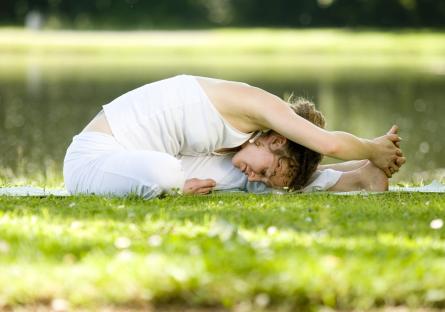This article appears for archival purposes. Any events, programs and/or initiatives mentioned may no longer be applicable.

If you spend a lot of time on your computer, you’re probably well aware of the importance of core muscles. You can feel it every time you stand up after sitting for hours: the stiffness in your hips, the sore back, your pelvis feeling like it’s been sitting on a wooden plank. If you feel these discomforts every day, that could be a sign that your core muscles are crying out for attention. One of the best things you can do to improve your overall health is to do more for your core.
Your Core Muscles
Imagine that your body has a barrel inside it. The top of the barrel is your diaphragm while the bottom lid is your pelvic floor. All the muscle groups contained between those two points are your core. These are the muscles that work to provide strength and support for your abdomen.
Your core muscles include:
- Rectus abdominis
- Internal/external obliques
- Erector spinae
- Transversus adominis
- Multifidus
- Quadratus lumborum
- Diaphragm
- Pelvic floor
Balance & Stability
Your core muscles are the central part of your body. So much of your ability to move and bend comes from your core muscles. Training and strengthening these muscles over time will help them work in harmony with each other, which can lead to an improved sense of balance and stability. Good balance is very important as it helps safeguard us from falls and other kinds of easily preventable injuries. For the elderly and/or overweight, a greater sense of stability can save them from potentially ruinous injuries.
Cost Effective
One of the major upsides to working your core is that it’s a very economical mode of exercise. You don’t need much in the way of equipment to do core exercises. While having a yoga mat and some free weights is a wise investment, you can do your core a world of good by simply doing equipment-free exercises like sit-ups, crunches, planks, bridges, and leg raises.
Stamina & Flexibility
Improving your core can make a host of other activities easier to do. Whether it’s lifting heavy objects around the house, bending down to tie your shoes, or swinging a golf club, you’ll find that your flexibility and dynamic range of motion will be smoother after you start working out your core. You’ll also find you’ll have more stamina and endurance when exercising or doing other intensive physical activities, as weak core muscles can lead you to more fatigue and less energy.
Posture
Another benefit that comes from having a stronger core is that it can improve your posture. Weak core muscles means a weaker back: poorer posture, back pain, and more prone to muscle injuries. Core workouts can help minimize that back pain and improve your posture, which over time will make you less likely to experience back pain in the first place.
Start Off Slowly
Slow and steady is the way to go with exercising your core. You don’t have to do a lot of reps early on or devote a tremendous amount of time to achieve results. The key is consistency. Above all, though, you want to make sure you’re using good form. Before you start doing crunches and planks and other core-strengthening exercises, see a trainer or watch some reputable fitness videos on YouTube to see how they are done. While training videos can be a great resource, it can be very helpful early on to either have a trainer or more experienced buddy watch you do your exercises because they can see errors you’re making that you may not be aware of. It’s critical to make sure you do these exercises right because doing them the wrong way could lead to injuries in the long run.
Article by Austin Brietta
Want more wellness tips? Check out these stories: